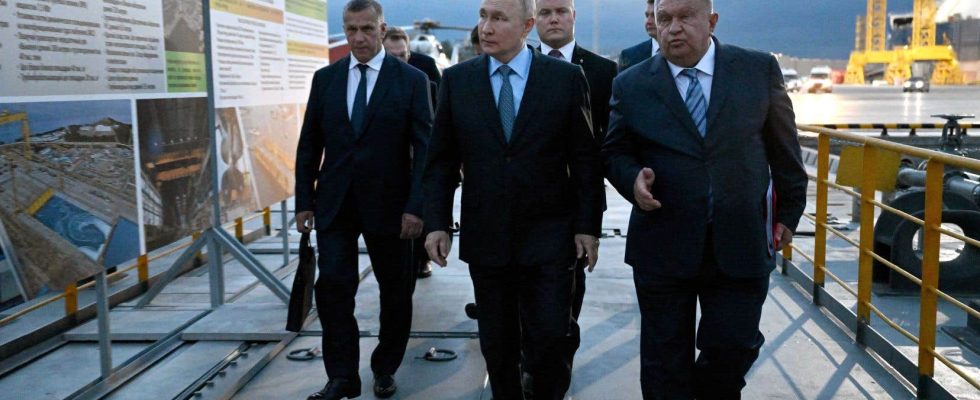Trade and militarization: Russia has further accelerated its development of the Arctic, deeming the region essential to the growth of its trade with Asia in particular to counterbalance the effects of Western sanctions imposed due to the Russian assault against Ukraine.
On Tuesday, Russian atomic energy giant Rosatom unveiled the latest of its RITM-200 reactors, “much lighter, compact and powerful”. It will equip its future latest generation nuclear-powered icebreaker Chukotkaa type of ship crucial to establishing the “Northern maritime route” as a new commercial circuit linking Europe and Asia.
Without such a fleet to overcome the ice obstacles encountered in Arctic waters, it is impossible to imagine a reliable and sustainable hydrocarbon trade. However, oil and gas are at the heart of Russia’s economy, which is now largely deprived of the markets it dominated until February 2022 and its offensive against Ukraine.
Vladimir Putin had already, before this conflict, made the exploitation of the resources of the Arctic and the Northern Sea Route a “strategic priority”, at a time when global warming is accelerating the melting of the ice and making these waters better navigable. . But a few months after the start of the assault in Ukraine, the Russian authorities stepped up their efforts, with the government validating an investment plan of around 20 billion euros until 2035 (almost CA$30 billion).
According to Moscow, the number of ports of call could be increased from 4 to 11 and the route extended to Vladivostok (Far East), allowing, according to Rosatom, the transport of 31.4 million tonnes of goods between January and October via the Arctic, ten times more than ten years ago.
Uncertainty
“Ukraine and the sanctions have, however, created uncertainty over the financing of several projects,” tempers Malte Humpert, founder of the American think tank The Arctic Institute, citing the example of Arctic LNG 2, a major gas production project. liquefied natural gas which was placed under American sanctions in early November. “But Russia has no other choice, the European market is no longer accessible. […] It must produce oil and gas and export them to generate money. However, the buyers are now in Asia. »
However, technological obstacles remain numerous in a country which is used to importing high value-added parts.
Concerning the Arctic fleet, “the replacement of a certain number of technologies from unfriendly countries is the main challenge to be met,” admitted Alexei Chekounkov, the minister responsible for the region, in May. In recent months, Russia has had to turn to third countries to obtain parts for its LNG tankers, which are often produced in Asia with Western technologies to which Moscow no longer has access.
At this stage, the Russian fleet is limited to 30 “operational” Arctic-class boats and “another 33 under construction”. However, ultimately, Russia needs around a hundred ships, according to Rosatom boss Alexei Likhachev.
Thus, if the Russian authorities aim to transport some 190 million tonnes of freight in 2030 via the Northern Sea Route, this volume is very far from competing with the Suez Canal and its 1.41 billion tonnes delivered in 2022.
Assumed militarization
Another consequence of the lack of Arctic tankers, Russia sent two conventional tankers to the Arctic in September towards China, without the assistance of an approved icebreaker to open the route for them.
A saving of time, certainly, but what are the consequences for the environment? “If ships without ice certification start sailing in these waters, then there could be a great risk of oil spills,” warns Mr. Humpert to AFP.
Militarily, the Arctic zone is also a strategic priority, with Russia sharing the region with its Western enemies: the United States, Canada and northern Europeans.
Thus, even in the midst of the war in Ukraine, Russia is constantly strengthening its Arctic capabilities, reopening or modernizing bases and airfields dating from the Soviet era. “Russia has also deployed S-300 and S-400 missiles, extended runways to accommodate planes capable of carrying nuclear bombs and built imposing radar installations,” lists Mr. Humpert.
Last August, the Northern Fleet, responsible for the Arctic, conducted military exercises including more than 8,000 soldiers and several submarines.
“Increased competition and militarization in the Arctic region, particularly from Russia and China, are worrying,” noted Admiral Rob Bauer, head of the NATO military committee, in November. “We must remain vigilant and prepare for the unexpected. »
